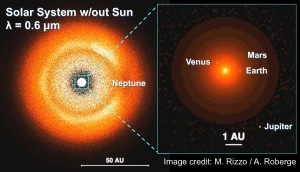
A slice from a high-fidelity model of the Solar System, viewed face-on from the outside. Image credit: M. Rizzo / A. Roberge from http://asd.gsfc.nasa.gov/projects/haystacks/haystacks.html.
Great talk today from Ashlee Wilkins, a grad student at University of Maryland Astronomy working at NASA Goddard, about imaging dust disks and planets around other stars.
Many stars, including the Sun, are surrounded by dust grains in disks, usually produced by collisions between asteroids and other larger bodies orbiting the stars. The orbits of these dust grains can then be shaped by gravitational interactions with planets in the system. Because the disks are much easier to observe than planets in these systems, they can provide clues to the presence of the otherwise unseen planets.
Wilkins and her collaborators are working to make very sophisticated models of such disks to learn what the disks would look like so that we can design telescopes to directly image planets in such systems. The image at left shows what our solar system might look like to astronomers on a distant planet, as produced by such a model. Wilkins is also helping to build the instruments that could directly image an Earth-like planet in a distant solar system.